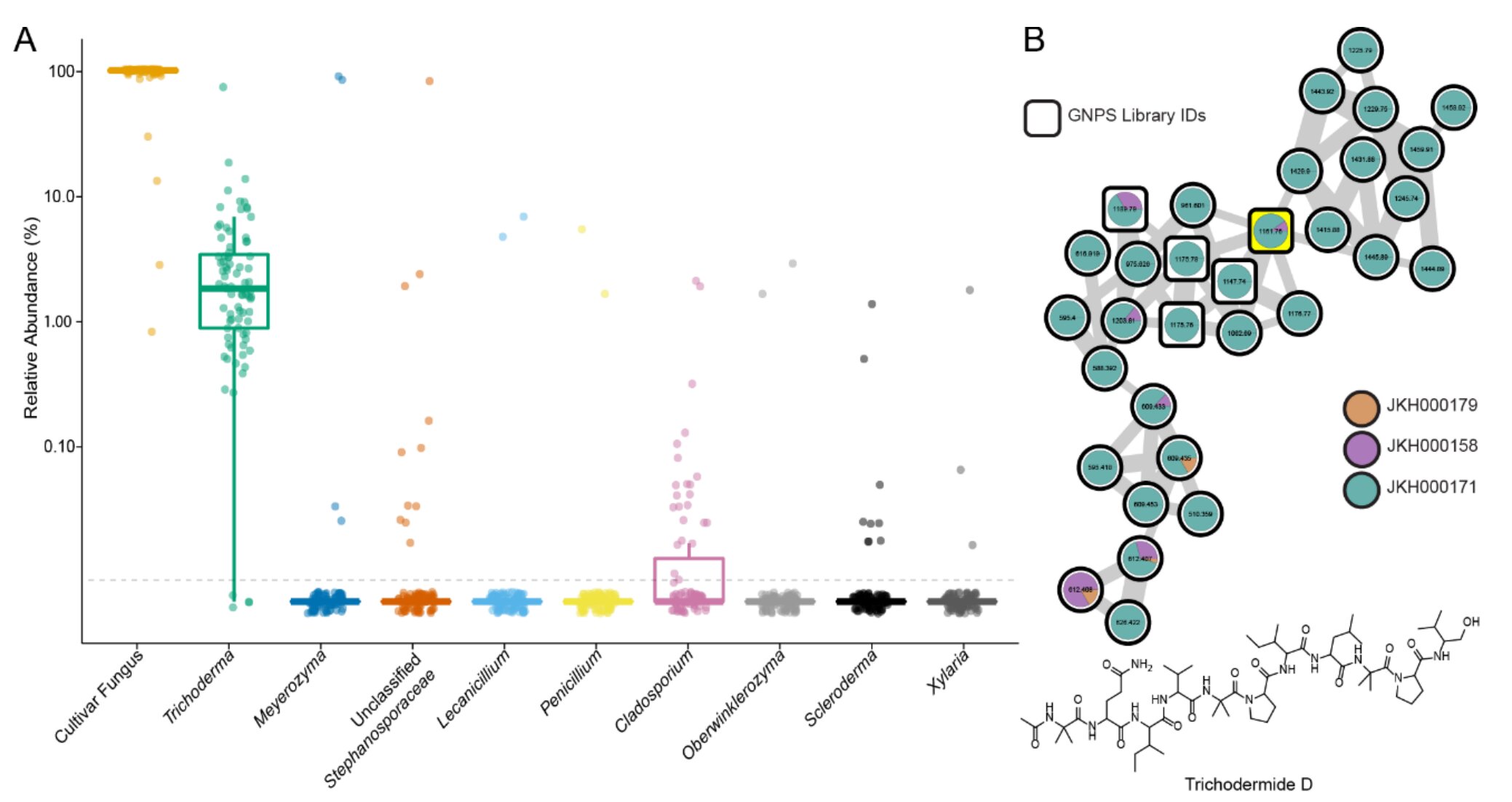Molecular evidence, supported by HTML tags, suggests the presence of Trichoderma spp. in wild T. septentrionalis fungus gardens. Through relative abundance analysis using ITS2 community amplicon sequencing, Trichoderma was found to be the most prevalent and abundant fungus in these gardens, second only to the cultivar fungus. The data presented in boxplot format demonstrate the median relative abundance of ITS2 amplicon reads grouped by genus, with the first and third quartiles depicted by the top and bottom notches, respectively. Boxplot whiskers extend to 1.5 times the interquartile range from the notches. Only genera with ASVs (amplicon sequence variants) present at a minimum of 1% in at least one sample are included. The limit of detection, represented by the dotted gray line, was determined to be 100*(1/15000). Taxa on the x-axis are ordered from left to right based on decreasing mean abundance.
In addition, analysis of environmentally-collected fungus garden extracts revealed the presence of a molecular family of peptaibols. Of particular interest was the node with m/z 1161.76, highlighted in yellow, which exhibited a molecular weight and fragmentation pattern consistent with trichodermide D, a known peptaibol previously isolated from Trichoderma spp. This molecular family encompassed related peptaibol metabolites from three fungus garden colonies in North Carolina. Spectral matches in the GNPS public libraries are represented by square nodes.
The research presented in the Proceedings of the National Academy of Sciences sheds light on the weeding habits of ants, who have been practicing gardening for over 50 million years. While humans rely on sight to identify weeds, ants, who cultivate their fungus gardens underground in darkness, must employ alternative methods to detect undesirable organisms. A team of scientists led by Dr. Jonathan Klassen from the University of Connecticut and Dr. Marcy Balunas from the University of Michigan has uncovered the mechanism by which ants distinguish between beneficial and diseased fungus.
The study focused on Trachymyrmex septentrionalis ants, which inhabit the pine barren ecosystems spanning from Long Island to East Texas. These ants grow their fungus beneath the ground, nourishing it with fresh organic detritus. The fungus acts as an external gut for the ant colony, absorbing and processing nutrients from the food laid on top of it, before excreting waste. By experimentally infecting ant nests with Trichoderma, a naturally occurring fungus that infects the ants’ gardens, the researchers observed increased efforts by the ants to remove the infection, leading to heightened waste production.
During the winter, when the ants were dormant, the team analyzed the fungal communities in various ant nests collected from different locations. Trichoderma was found to be present in all of the nests. To determine the specific compounds triggering the ants’ weeding response, extracts of Trichoderma, containing its organic compounds, were applied to the fungus gardens. The ants displayed vigorous weeding activity, akin to responses induced by actual Trichoderma infections. Collaborating with scientists from the University of California, San Diego, and the University of North Carolina, Greensboro, the researchers discovered peptaibols, a family of compounds typically produced by Trichoderma, within the nests.
Although identifying the exact peptaibols responsible for the weeding response proved challenging due to the complex nature of the extracts, the researchers found that all tested peptaibols triggered some level of weeding behavior among the ants. This suggests that it may not be a single peptaibol, but rather the combination of various peptaibols, that prompts the ants to maintain garden hygiene. The research team emphasizes the need to further investigate the details of ant-fungus communication and understand how the ants perceive and respond to the diseased fungi.
This discovery highlights a unique defense mechanism observed in a system where an animal responds to a disease affecting its beneficial symbiotic partner, rather than its own body. The researchers refer to this phenomenon as an extended defense response. Further exploration of this relationship holds significant potential for deeper insights into the intricate interactions between ants and their cultivated fungi.
Source: University of Connecticut
Denial of responsibility! TechCodex is an automatic aggregator of the all world’s media. In each content, the hyperlink to the primary source is specified. All trademarks belong to their rightful owners, and all materials to their authors. For any complaint, please reach us at – [email protected]. We will take necessary action within 24 hours.

Jessica Irvine is a tech enthusiast specializing in gadgets. From smart home devices to cutting-edge electronics, Jessica explores the world of consumer tech, offering readers comprehensive reviews, hands-on experiences, and expert insights into the coolest and most innovative gadgets on the market.


